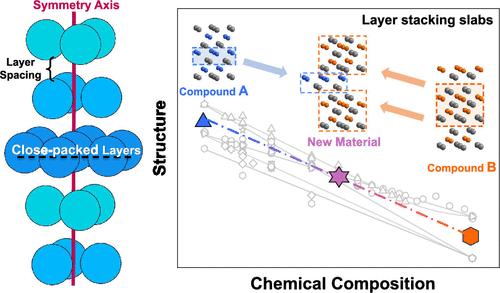Designing Semiconductors from the Assembly of Close-Packed Slabs
IF 7
2区 材料科学
Q2 CHEMISTRY, PHYSICAL
引用次数: 0
Abstract
The crystal structures significantly affect the electrical, optical, and mechanical properties of materials, leading to exotic physical phenomena in advanced functional materials. Solid solutions are often employed for crystal manipulation with the goal of discovering new atomic structures possessing novel properties. A practical guideline for adjusting the atomic structure symmetry of different materials is highly expected for the design of functional materials. By examining the similarity of close-packed layers in inorganic materials with different functionalities, a linear dependency between structural symmetry and composition is revealed. “Layer stacking slabs” can serve as a concise and practical pathway for structural manipulation by layer-stacking-unit rearrangement, which is promising for designing materials with various crystal symmetries and characteristics. This layer-stacking-oriented structure manipulation is further confirmed by X-ray diffraction, transmission electron microscopy imaging, and synchrotron X-ray pair distribution function analysis. Following the close-packed layer spacing guidance, a new possible thermoelectric material system of (I–V–VI2)–(V2–VI3) has been experimentally synthesized in this work, thereby expanding the range of thermoelectric candidates. The layer-spacing-based structural indicator exhibits the potential for accelerating the exploration of new functional materials across different application fields.

通过组装紧密堆积的平板设计半导体
晶体结构对材料的电学、光学和机械特性有重大影响,从而导致先进功能材料出现奇特的物理现象。固溶体通常被用于晶体操纵,目的是发现具有新特性的新原子结构。调整不同材料的原子结构对称性的实用指南对于功能材料的设计非常重要。通过研究具有不同功能的无机材料中紧密堆积层的相似性,揭示了结构对称性与成分之间的线性关系。"层堆积板 "可以作为通过层堆积单元重排进行结构操作的简明实用途径,在设计具有不同晶体对称性和特性的材料方面大有可为。X 射线衍射、透射电子显微镜成像和同步辐射 X 射线对分布函数分析进一步证实了这种以层堆积为导向的结构操作。在紧密堆积层间距的指导下,本研究通过实验合成了一种新的可能的热电材料体系(I-V-VI2)-(V2-VI3),从而扩大了热电候选材料的范围。基于层间距的结构指示器具有加速探索不同应用领域新型功能材料的潜力。
本文章由计算机程序翻译,如有差异,请以英文原文为准。
求助全文
约1分钟内获得全文
求助全文
来源期刊

Chemistry of Materials
工程技术-材料科学:综合
CiteScore
14.10
自引率
5.80%
发文量
929
审稿时长
1.5 months
期刊介绍:
The journal Chemistry of Materials focuses on publishing original research at the intersection of materials science and chemistry. The studies published in the journal involve chemistry as a prominent component and explore topics such as the design, synthesis, characterization, processing, understanding, and application of functional or potentially functional materials. The journal covers various areas of interest, including inorganic and organic solid-state chemistry, nanomaterials, biomaterials, thin films and polymers, and composite/hybrid materials. The journal particularly seeks papers that highlight the creation or development of innovative materials with novel optical, electrical, magnetic, catalytic, or mechanical properties. It is essential that manuscripts on these topics have a primary focus on the chemistry of materials and represent a significant advancement compared to prior research. Before external reviews are sought, submitted manuscripts undergo a review process by a minimum of two editors to ensure their appropriateness for the journal and the presence of sufficient evidence of a significant advance that will be of broad interest to the materials chemistry community.
 求助内容:
求助内容: 应助结果提醒方式:
应助结果提醒方式:


